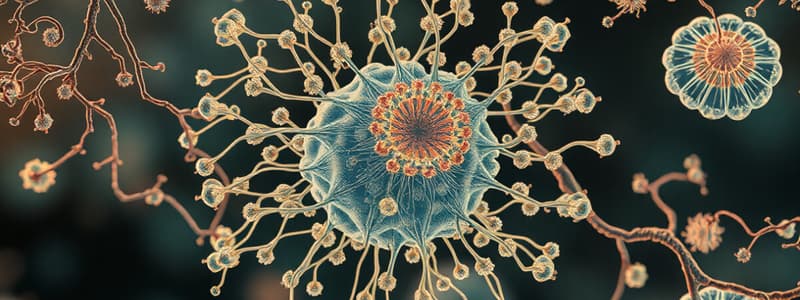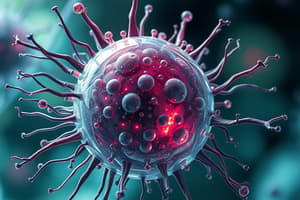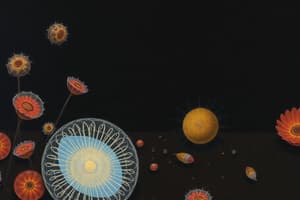Podcast
Questions and Answers
Which type of organism is composed of only one cell?
Which type of organism is composed of only one cell?
- Multicellular organism
- Unicellular organism (correct)
- Colonial organism
- Eukaryotic organism
Eukaryotes can only be unicellular organisms.
Eukaryotes can only be unicellular organisms.
False (B)
What is the main function of chloroplasts in plant cells?
What is the main function of chloroplasts in plant cells?
Conduct photosynthesis
Cells become _____ to perform specific functions through the process of differentiation.
Cells become _____ to perform specific functions through the process of differentiation.
Match the following organelles with their primary functions:
Match the following organelles with their primary functions:
Which of the following statements about cellular specialisation is true?
Which of the following statements about cellular specialisation is true?
Flagella are structures used for movement in multicellular organisms.
Flagella are structures used for movement in multicellular organisms.
What term describes the breakdown of work into smaller specific tasks for maximum efficiency?
What term describes the breakdown of work into smaller specific tasks for maximum efficiency?
What is the primary role of connective tissue?
What is the primary role of connective tissue?
A high surface area to volume (SA:V) ratio is beneficial for diffusion in larger organisms.
A high surface area to volume (SA:V) ratio is beneficial for diffusion in larger organisms.
Name one example of an autotroph.
Name one example of an autotroph.
The main function of __________ in leaves is to regulate gas exchange.
The main function of __________ in leaves is to regulate gas exchange.
Match the types of tissues with their primary functions:
Match the types of tissues with their primary functions:
What type of organism requires other organisms for nutrition?
What type of organism requires other organisms for nutrition?
Alveoli are responsible for gas exchange in the leaves of plants.
Alveoli are responsible for gas exchange in the leaves of plants.
What do vascular bundles in plant stems consist of?
What do vascular bundles in plant stems consist of?
A __________ obtains energy for carbon fixation from sunlight.
A __________ obtains energy for carbon fixation from sunlight.
Match the isotopes with their functions in plants:
Match the isotopes with their functions in plants:
Which structure allows for gas exchange in animal lungs?
Which structure allows for gas exchange in animal lungs?
Plants release carbon dioxide during photosynthesis.
Plants release carbon dioxide during photosynthesis.
What is the relationship between the size of an organism and its reliance on specialized structures?
What is the relationship between the size of an organism and its reliance on specialized structures?
The __________ is a group of organs that work together to perform a specific function.
The __________ is a group of organs that work together to perform a specific function.
Which type of tissue would you expect to find in the walls of your heart?
Which type of tissue would you expect to find in the walls of your heart?
What is the primary gas that diffuses into leaves during photosynthesis?
What is the primary gas that diffuses into leaves during photosynthesis?
Fish breathe by absorbing oxygen directly from the air through their gills.
Fish breathe by absorbing oxygen directly from the air through their gills.
What conclusion did Jan Baptista van Helmont mistakenly reach regarding plant growth?
What conclusion did Jan Baptista van Helmont mistakenly reach regarding plant growth?
The __________ is a tissue that transports sugars throughout the plant.
The __________ is a tissue that transports sugars throughout the plant.
Match the animal with its gas exchange method:
Match the animal with its gas exchange method:
What happens to water as it evaporates from the leaf surface?
What happens to water as it evaporates from the leaf surface?
Cohesion refers to the attraction between different types of molecules.
Cohesion refers to the attraction between different types of molecules.
What primary role does the xylem perform in plants?
What primary role does the xylem perform in plants?
Joseph Priestly discovered that plants restore oxygen to the air after it has been used by __________.
Joseph Priestly discovered that plants restore oxygen to the air after it has been used by __________.
Which part of the heart receives oxygenated blood?
Which part of the heart receives oxygenated blood?
Stomata are responsible for diffusion of carbon dioxide into plant leaves.
Stomata are responsible for diffusion of carbon dioxide into plant leaves.
What is the primary mechanism of water transport in xylem called?
What is the primary mechanism of water transport in xylem called?
Match the following processes with their corresponding descriptions:
Match the following processes with their corresponding descriptions:
What is the main function of the digestive system?
What is the main function of the digestive system?
Osmosis involves the movement of sugars in plants.
Osmosis involves the movement of sugars in plants.
What does the term 'translocation' refer to in plant biology?
What does the term 'translocation' refer to in plant biology?
The _______ is the first part of the small intestine, where chemical digestion is very active.
The _______ is the first part of the small intestine, where chemical digestion is very active.
Match the following digestive enzymes with their functions:
Match the following digestive enzymes with their functions:
Which of the following macromolecules is essential for normal growth and metabolic processes?
Which of the following macromolecules is essential for normal growth and metabolic processes?
The left ventricle pumps oxygen-poor blood into the lungs for oxygenation.
The left ventricle pumps oxygen-poor blood into the lungs for oxygenation.
What is the primary role of the colon in the digestive system?
What is the primary role of the colon in the digestive system?
A _______ is a low molecular weight organic compound that is essential for normal metabolic processes.
A _______ is a low molecular weight organic compound that is essential for normal metabolic processes.
What transports nutrients from the small intestine to the rest of the body?
What transports nutrients from the small intestine to the rest of the body?
The heart is responsible for filtering blood in the body.
The heart is responsible for filtering blood in the body.
What do autotrophs require for energy production?
What do autotrophs require for energy production?
Peristalsis is the series of involuntary contractions that occur in the _______ tract.
Peristalsis is the series of involuntary contractions that occur in the _______ tract.
Which of the following nutrients is primarily absorbed in the ileum?
Which of the following nutrients is primarily absorbed in the ileum?
What is the primary function of white blood cells?
What is the primary function of white blood cells?
Capillaries are the largest blood vessels in the body.
Capillaries are the largest blood vessels in the body.
What is the role of the xylem in plants?
What is the role of the xylem in plants?
The stomata are surrounded by two _____ cells.
The stomata are surrounded by two _____ cells.
Match the following statements with the correct circulatory system:
Match the following statements with the correct circulatory system:
Which of the following describes the capillary function?
Which of the following describes the capillary function?
The root system's main function is to produce glucose for plant growth.
The root system's main function is to produce glucose for plant growth.
What is the disadvantage of a closed circulatory system?
What is the disadvantage of a closed circulatory system?
The _____ mesophyll is composed of loosely packed cells to allow gas exchange.
The _____ mesophyll is composed of loosely packed cells to allow gas exchange.
Which of the following statements about blood composition as it moves through the kidney is correct?
Which of the following statements about blood composition as it moves through the kidney is correct?
Study Notes
Organisation of Cells
- All prokaryotes are unicellular; eukaryotes can be unicellular or multicellular.
- Unicellular organisms include archaea, bacteria, and protozoa; they perform all life processes.
- Colonial organisms consist of individual cells living closely to ensure survival without specialization.
- Multicellular organisms have specialized cells that depend on each other for survival and efficiency.
- Cellular specialization allows diverse functions to be performed simultaneously in multicellular organisms.
- Organelles such as chloroplasts conduct photosynthesis and contain chlorophyll for glucose production.
- Mitochondria perform cellular respiration, generating ATP as the energy currency of the cell.
- Ribosomes, found in rough ER, are responsible for protein synthesis.
Tissues, Organs, and Systems
- Cell differentiation enables specialization for specific functions, triggered by internal or external stimuli.
- Organ: a structure composed of tissues that perform specific functions.
- Tissue types: connective, epithelial, muscle, and nervous.
- Organ system: a group of organs working together to carry out distinct functions.
- Hierarchical organization in multicellular organisms includes cells → tissues → organs → organ systems → organisms.
Size and Surface Area
- As an object increases in size, both surface area and volume grow, but the surface area-to-volume (SA:V) ratio decreases.
- High SA:V ratios facilitate diffusion; low SA:V ratios necessitate specialization to meet metabolic needs.
Nutrient and Gas Requirements
- Autotrophs synthesize their own food from inorganic materials (e.g., plants and algae).
- Heterotrophs obtain energy by consuming other organisms (e.g., animals and fungi).
- Photoautotrophs use sunlight for energy; chemoautotrophs derive energy from inorganic chemical reactions.
Plant Structure and Function
- Leaves are plant organs with layers like mesophyll, rich in chloroplasts for photosynthesis.
- Stomata are pores surrounded by guard cells, regulating water loss during transpiration.
- Stems connect roots and leaves, containing xylem and phloem for nutrient and water transport.
- Xylem transports water upward, while phloem distributes sugars from leaves to other plant parts through the source-to-sink model.
Gas Exchange
- Gas exchange involves oxygen and carbon dioxide; oxygen maintains cellular respiration, while carbon dioxide needs removal to prevent toxicity.
- Alveoli in mammals enable gas exchange; they are thin-walled sacs surrounded by capillaries facilitating diffusion.
- In plants, gas exchange occurs via stomata where carbon dioxide enters for photosynthesis and oxygen exits.
Transpiration and Nutrient Transport
- Transpiration-cohesion-tension theory explains water transport in plants; cohesion keeps water molecules linked as they rise in xylem.
- The structure of phloem (consisting of living tissue with sieve plates and companion cells) allows sugar movement throughout the plant.
- Source-to-sink theory emphasizes the transport of sucrose from production areas to growth areas.
Digestion
- Digestion breaks down food into absorbable nutrients; it involves both physical (chewing, peristalsis) and chemical (enzyme action) processes.
- Nutrients, minerals, and water are absorbed primarily in the small intestine, specifically through the walls of villi.
- The digestive process includes sections of the small intestine: duodenum (chemical digestion), jejunum (nutrient absorption), and ileum (water-soluble vitamin absorption).
Comparisons
- Organisms consist of four biological macromolecules: carbohydrates, lipids, proteins, and nucleic acids, primarily made of CHONPS (carbon, hydrogen, oxygen, nitrogen, phosphorus, and sulfur).
Transport Systems
- The circulatory system, comprising the heart, blood, arteries, veins, and capillaries, transports oxygen and nutrients and removes waste.
- The heart consists of four chambers: left/right atria and left/right ventricles, facilitating blood circulation.
- Blood serves three primary functions: transport, protection, and regulation of body temperature, with plasma comprising 90% water and 10% other substances.### Blood and its Components
- Plasma is essential in treating burns, shock, trauma, and medical emergencies due to its proteins and antibodies.
- Therapies for rare chronic conditions like hemophilia and autoimmune disorders utilize proteins and antibodies from plasma.
- Red blood cells, produced in red bone marrow, are disk-shaped and transport oxygen and carbon dioxide for 120 days.
- White blood cells (leukocytes) protect against bacteria and viruses; they create antibodies through special proteins that identify foreign materials.
- Platelets are fragments crucial for blood clotting; they adhere to broken cells and secrete clotting factors to form clots.
Blood Vessel Types
- Arteries transport oxygen-rich blood away from the heart; they have thick, elastic walls to withstand high pressure.
- Veins bring oxygen-poor blood back to the heart; they have thinner walls and larger lumens.
- Capillaries are the smallest blood vessels with one-cell-thick walls, vital for nutrient and oxygen delivery as well as waste absorption.
Plant Structure and Vascular Systems
- Autotrophs (plants) possess vascular, root, and shoot systems for structure and transport.
- The vascular system consists of xylem, transporting water and inorganic substances, and phloem, moving organic nutrients like sucrose.
- Root systems anchor plants and efficiently absorb water/minerals, with a branching structure to maximize surface area.
- Stem and shoot systems support leaves for photosynthesis and flowers for reproduction, facilitating fluid transport.
- Leaves contain stomata, controlled by guard cells, which regulate gas exchange and water loss.
Gas Exchange in Plants and Animals
- Investigate how gases move between internal and external environments.
- Closed circulatory systems circulate blood via enclosed vessels; found in vertebrates like fish, amphibians, reptiles, and mammals.
- Open circulatory systems involve pumping hemolymph into a hemocoel surrounding tissues; common in molluscs and arthropods.
Characteristics of Circulatory Systems
- Closed systems deliver fluids directly to cells; open systems allow fluids to bathe organs for diffusion.
- Common functions of both systems include transporting oxygen, nutrients, waste products, and immune cells.
Advantages and Disadvantages of Closed Circulatory Systems
- Advantages: Efficient oxygen delivery, better waste removal, pressure from heart enhances circulation, and an independent lymphatic system.
- Disadvantages: Higher energy requirements and greater system complexity.
Changes in Transport Medium Composition
- During cellular respiration, oxygen and glucose decrease, while carbon dioxide and urea increase in composition as blood passes through various organs:
- Heart: O2 decreases, glucose decreases, CO2 increases, urea increases.
- Brain: O2 decreases, glucose decreases, CO2 increases, urea increases.
- Lungs: O2 increases, glucose decreases, CO2 decreases, urea increases.
- Kidney: O2 decreases, glucose decreases, CO2 increases, urea increases.
- Small Intestine: O2 decreases, glucose increases, CO2 increases, urea increases.
Studying That Suits You
Use AI to generate personalized quizzes and flashcards to suit your learning preferences.
Description
Explore the fascinating world of cells with this quiz on cell and organelle structures. Learn about the differences between prokaryotes and eukaryotes, and the significance of unicellular organisms. Delve into the characteristics of archaea, bacteria, and protozoa in this engaging assessment.




